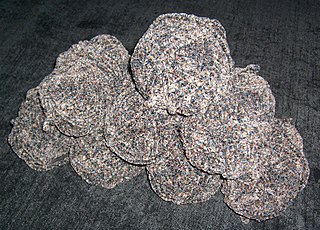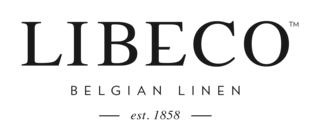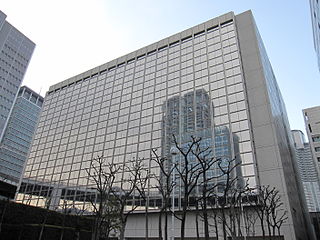
A textile is a flexible material consisting of a network of natural or artificial fibers. Yarn is produced by spinning raw fibres of wool, flax, cotton, hemp, or other materials to produce long strands. Textiles are formed by weaving, knitting, crocheting, knotting or tatting, felting, or braiding.

Satin is a fabric that typically has a glossy surface and a dull back, one of three fundamental types of textile weaves along with plain weave and twill. The satin weave is characterized by four or more fill or weft yarns floating over a warp yarn, four warp yarns floating over a single weft yarn. Floats are missed interfacings, for example where the warp yarn lies on top of the weft in a warp-faced satin. These floats explain the high luster and even sheen, as unlike in other weaves, the light reflecting is not scattered as much by the fibres. Satin is usually a warp-faced weaving technique in which warp yarns are "floated" over weft yarns, although there are also weft-faced satins. If a fabric is formed with a satin weave using filament fibres such as silk, polyester or nylon, the corresponding fabric is termed a satin, although some definitions insist that the fabric be made from silk. If the yarns used are short-staple yarns such as cotton, the fabric formed is considered a sateen.

Irish linen is the brand name given to linen produced in Ireland. Linen is cloth woven from, or yarn spun from the flax fibre, which was grown in Ireland for many years before advanced agricultural methods and more suitable climate led to the concentration of quality flax cultivation in northern Europe. Since about the 1950s to 1960s the flax fibre for Irish Linen yarn has been, almost exclusively, imported from France, Belgium and the Netherlands. It is bought by spinners who produce yarn and this, in turn, is sold to weavers who produce fabric. Irish linen spinning has now virtually ceased, yarns being imported from places such as the Eastern part of the European Union and China.

The textile industry is primarily concerned with the design, production and distribution of yarn, cloth and clothing. The raw material may be natural, or synthetic using products of the chemical industry.

Chenille may refer to either a type of yarn or fabric made from it. Chenille is the French word for caterpillar whose fur the yarn is supposed to resemble.

Cloth of gold or gold cloth is a fabric woven with a gold-wrapped or spun weft—referred to as "a spirally spun gold strip". In most cases, the core yarn is silk wrapped (filé) with a band or strip of high content gold. In rarer instances, fine linen and wool have been used as the core.

The National Textile University (NTU) is a public university located in Faisalabad, Punjab, Pakistan. It is the premier institution of textile education in Pakistan.
In the history of textiles, frieze is a Middle English term for a coarse woollen, plain weave cloth with a nap on one side. The nap was raised by scrubbing it to raise curls of fibre, and was not shorn after being raised, leaving an uneven surface. Panni frisi, "Frisian cloths", appear in medieval inventories and other documents. Frieze was woven in the English Midlands and Wales, and in Ireland from the fourteenth century, and later in Holland as well. A similar textile is baize. In Old Norse, such cloth was called vaðmál (wadmal), and lengths of wadmal were a medium of exchange, especially for the poor who had neither cattle nor silver. Wadmal could be used to pay property tax.

Libeco is a Belgian textile company which manufactures and distributes linen and linen products. The company grew out of the merger of Libeco and Lagae on 2 June 1997. The head office is located in Meulebeke in a region of Flanders, Belgium, which is known for its flax culture and textile industry.
Sioen Industries is a Belgian textile manufacturer and a diversified stock quoted Group with an extensive portfolio of products and activities: spinning, weaving, and coating of technical textiles, manufacturer of professional protective clothing and producer of fine chemicals. The company head office is located in Ardooie.
S. Kumars Nationwide Limited or SKNL is a textile and apparel company with expertise in multi-fibre manufacturing presently under liquidation. The company has extended its presence in multiple product categories from fabrics to apparels and home textiles.
The design, manufacture and export of textiles and apparel products is one of the biggest industries in Sri Lanka, and one which plays a key role in advancing the country's economy. The apparel industry of Sri Lanka employs about 15% of the country's workforce, accounting for about half of the country's total exports, and Sri Lanka is among the top apparel-producing countries in the world relative to its population.

Toyobo Co., Ltd. is one of Japan's top makers of fibers and textiles, including synthetic fibers and natural fibers, such as cotton and wool.
The Textile Engineering College, Chittagong is a college in Bangladesh, offering bachelor's degree in textile engineering. It is situated by the side of old Dhaka Trunk road which passes through Zorargonj, Mirsharai, Chittagong. It is one of the seven textile engineering colleges which are collectively funded and controlled by the Ministry of Textiles and Jute.
The textile industry in India traditionally, after agriculture, is the only industry that has generated huge employment for both skilled and unskilled labour in textiles. The textile industry continues to be the second-largest employment generating sector in India. It offers direct employment to over 35 million in the country. The share of textiles in total exports was 11.04% during April–July 2010, as per the Ministry of Textiles. During 2009–2010, the Indian textile industry was pegged at US$55 billion, 64% of which services domestic demand. In 2010, there were 2,500 textile weaving factories and 4,135 textile finishing factories in all of India. According to AT Kearney’s ‘Retail Apparel Index’, India was ranked as the fourth most promising market for apparel retailers in 2009.

The Museum of Industry, Work and Textiles is a museum in Ghent in Belgium. Ghent was at the centre of the Flanders textile region. The museum is an Anchor point on the European Route of Industrial Heritage.

Mandhana Industries Limited is an Indian diversified textile and apparel manufacturing company, headquartered in Mumbai, Maharashtra.
The textile industry in China is the largest in the world in both overall production and exports. China exported $274 billion in textiles in 2013, a volume that was nearly seven times that of India, the second largest exporter with $40 billion in exports. This accounted for 43.1% of global clothing exports.
An air-jet loom is a shuttleless loom that uses a jet of air to propel the weft yarn through the warp shed. It is one of two types of fluid-jet looms, the other being a water-jet loom, which was developed previously. Fluid-jet looms can operate at a faster speed than predecessor looms such as rapier looms, but they are not as common. The machinery used in airjet weaving consists of a main nozzle, auxiliary nozzles or relay nozzles, and a profile reed.
Manufacturing Innovation Hub for Apparel, Textiles + Wearable Tech is a business incubator in Brooklyn. It is housed on the fifth floor of Storehouse No. 2, U.S. Navy Fleet Supply Base, a 1,100,000-square-foot (100,000 m2) building at 850 Third Avenue owned by the City of New York, which has been renamed to Liberty View Industrial Plaza.










